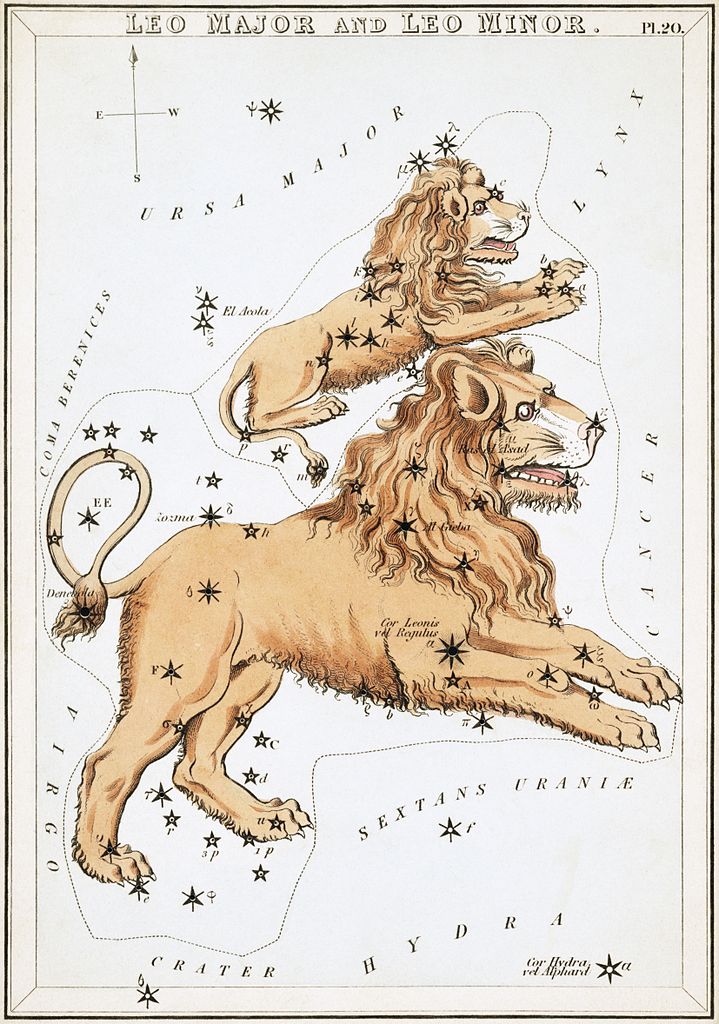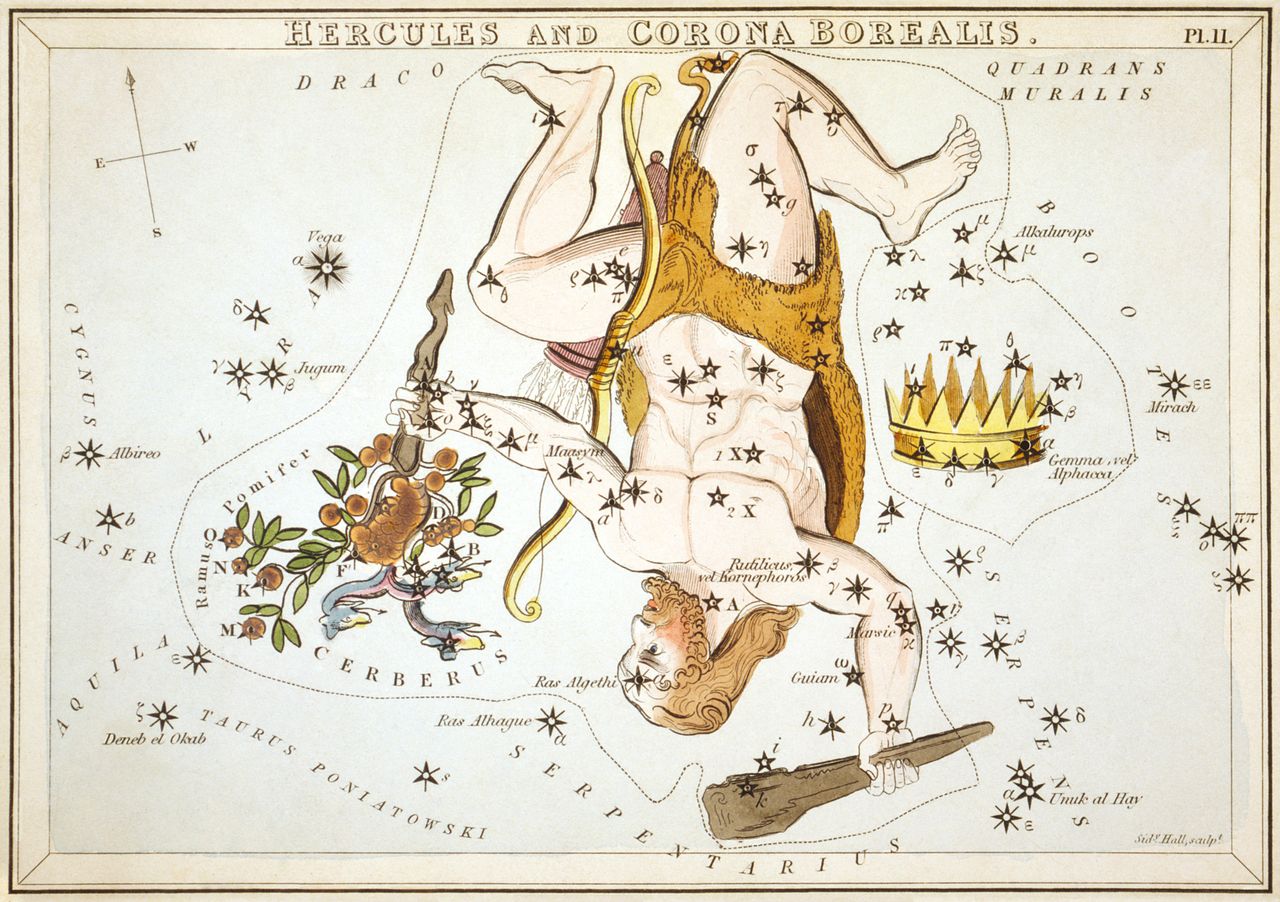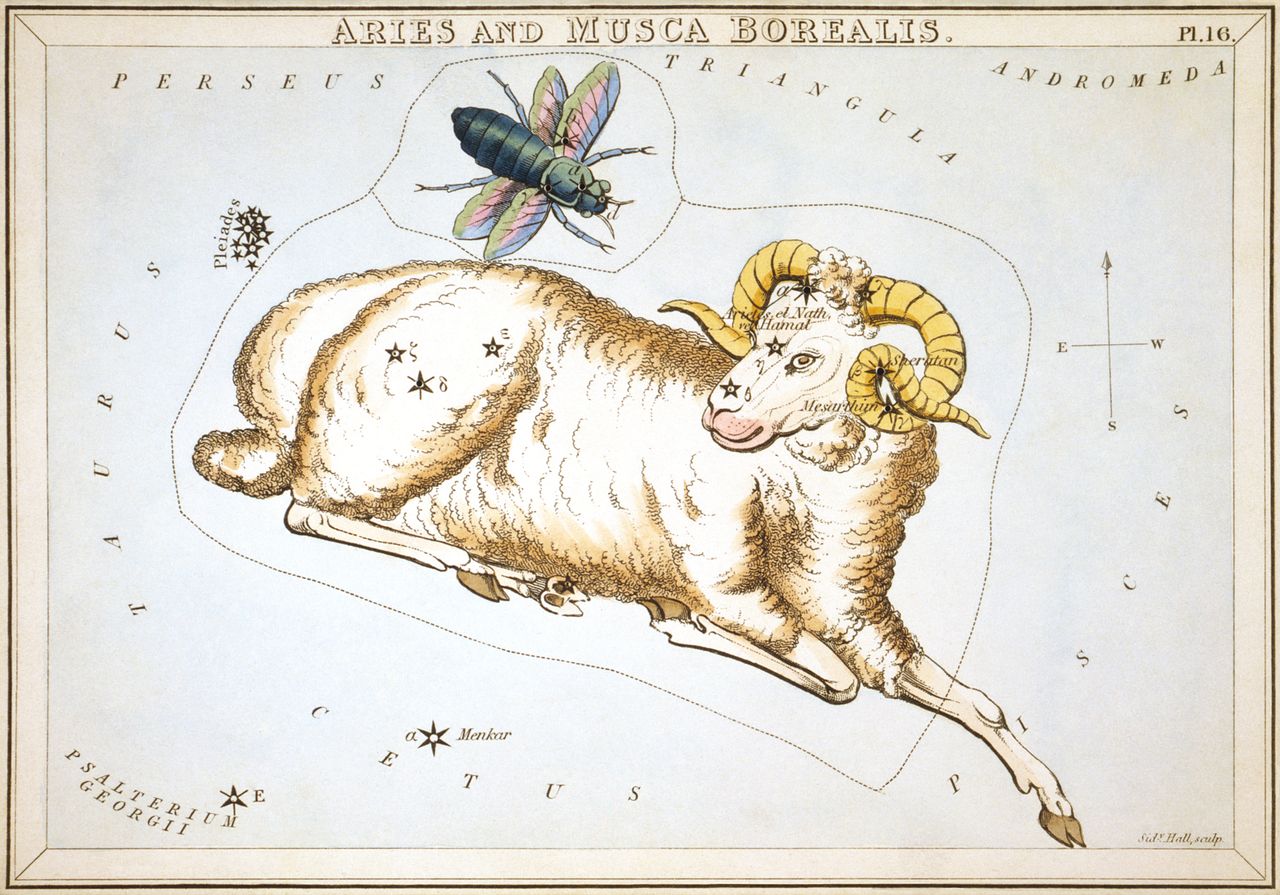Author Archives: Swany
a certain kind of Pantagruelion cannot be consumed by fire
How a certain kind of Pantagruelion cannot be consumed by fire.
Original French: Comment certaine espece de Pantagruelion peut estre par feu conſommée.
Modern French: Comment certaine espèce de Pantagruelion peut estre par feu consommée.
See Pantagruelion.
Notes
certaine espece de Pantagruelion
Asbeste, espece de lin incombustible comme l’amiante.
Comment … chapitre LII
Addition de 1552
certaine espèce de Pantagruelion peut estre par feu consommée
Rabelais en 1552 ajoute une réference à l’eon et au chêne dont fut construite la célèbre nef Argo. Ces additions explicitent le dessein de Rabelais dans ce dernier chapitre.
Il n’est pas impossible qu’eon doive être pris dans un sens symbolique. K. Baldinger, «Eon, plante énigmatique chez Rabelais, et le Pantagruélion», Études rabelaisiennes, XXIX, 1993, p. 139-144, a rapprochée le mot d’eon (chacune des puissances éternelles émanées de l’être suprême et par lesquelles s’exerce son action dans le monde, selon Balentin et les gnostiques [Trévous, 1721]) du grec αίών, «l’esprit du monde, l’éternité». Selon lui, p. 144, Rabelais devait rattacher le terme à aeon «d’autant plus que cette interprétation coïncidait parfaitement avec l’essence de sa pensée et le sens profond du pantagruélion.».
La référence à la nef Argo est en relation avec la lecture alchimique de de la conquête de la Toison d’or que Rabelais donne dans le Quart livre (voir la Notice de cette œuvre, p. 1464). Par ailleurs, le pantagruélion n’est pas seulement le lin-chanvre suggéré par les descriptions botaniques du chapitre XLIV. Ce chapitre porte sue les vertus de pantagruélion asbeste. Dans Gargantua («la pierre dit ἁσβεστοζ»; voir V, p. 19 et n. 22; ici, p. 510 et n. 6), l’asbeston est une pierre, vraisemblablement l’amiante. Les Ancien s’en servaient pour faire des lincuels incombustibles que recueillaient la cendre des morts. Elle est pour les alchimistes le nom qu’ils donnent à leur pierre dans la mesure où elle résiste aux atteintes du feu (voir n. 4, p. 400). L’incombustibilité est ici la particularité essentielle du pantagruélion; dans la liste des elements incombustibles qu’il surpasse dans son excellence — salamandre, alun de plomb, éon, mélèze —, il est dit que ce dernier qu’il pourrait être digne d’être vrai pantagruélion. La blancheur du pantagruélion est aussi soulignée. Or, l’incombustibilité et la blancheur sont les caractéristiques mêmes de la matière des alchimistes après la putrification, la matière ayant alors «acquis un degré de fixie que le feu ne sçauroit detruire» (ibid, p. 58). Derrière le pantagruélion, Rabelais entend donc aussi la pierre philosophale, utilisant comme dans Thélème les ressources de l’art stéganographique (voir la Notice de Gargantua, p. 1042), proposant ainsi comme dans l’énigme en prophétie des objects différents à la sagacité de son lecteur.
La lecteur alchimique explicitée ici pour le pantagruélion appelé asbeston autorise peut-être certains rapprochements dans les chapitres précédents. Les adeptes ont-ils pu être tentés, derrière la pantagruélion vert, de distinguer le lion vert, matière employée pour le magistère des sages?
Fragment 511471
Finally they put the remedy of obviating it in deliberation, and to council.
Original French: En fin ont mis le remede de y obuier en deliberation, & au conſeil.
Modern French: En fin ont mis le remède de y obvier en deliberation, & au conseil.
which are the only means to become deified
which are the only means to become deified.
Original French: qui ſont les ſeulx moyens d’eſtre deifiez.
Modern French: qui sont les seulx moyens d’estre deifiez.
Notes
Has for wife
[Odysseus recounting his visit to Hades.] And after him I became aware of the mighty Heracles—his phantom; for he himself among the immortal gods takes his joy in the feast, and has for wife Hebe of the beautiful ankles, daughter of great Zeus and of Hera of the golden sandals.
Ecologue 4
cui non risere parentes, nec deus hunc mensa, dea nec dignata cubili est.
The child who has not won a smile from his parents, no god ever honoured with his table, no goddess with her bed!
[Note: As Hercules was honoured (cf. Homer, Odyssey 11.602–4)]
Serv. Ecl. 6.62
62] tum phaethontiadas Clymenes et Solis filias, quae dum extinctum fratrem flerent, conversae sunt in arbores: ut hoc loco dicit, in alnos, ut in decimo, in populos; ubi etiam plenius hanc diximus fabulam. mira autem est canentis laus, ut quasi non factam rem cantare, sed ipse eam cantando facere videatur. sane ingeniose hominis mentionem cum re, quae animam non habet, miscuit. sorores Phaethontis sucina flevisse dicuntur. et quidam alnos poetica consuetudine pro populis accipiunt.
[62] as well as Phae Clymene and daughters of the Sun, which has been put out as long as they mourn, brother, were changed into trees, so that in this passage he says, in the alder-hulls, as in the tenth was on the people: we have said, where there is also more fully this story. remarkable, however, is the praise of the bard ‘, as it were, in order that the matter has been made not to sing, but he himself may seem to make it in singing. person of ability, of course, mention with the facts, that the soul does not have, she mixed. Phaethon amber sisters are said to have wept. And some people take for custom alder poetry.] Google translate
Comment Pantagruel explore par sors Virgilianes, quel sera le mariage de Panurge
Chapitre XII.
Doncques ouvrant Panurge le livre, rencontra on ranc sezième ce vers.
Nec Deux hunc mensa, Dea nec dignata cubili est.
Digne ne feut d’estre en table du Dieu,
Et n’eut on lict de la Déesse lieu.
Cestuy (dist Pantagruel) n’est à vostre adventaige. Il denote que vostre femme sera ribaulde, vous coqu par consequent.
How Pantagruel exploreth by the Virgilian Lottery how Panurge’s Marriage will turn out
THEN Panurge, on opening the Book, found on the sixteenth Line the following Verse :
Nec deus hunc mensa, dea nec dignata cubili est.
Nor at the God’s Table thought worthy a Place,
Nor him in his Marriage the Goddess would grace.
“This,” said Pantagruel, “is not to your Advantage. It denotes that your Wife will be a Strumpet, and you a Cuckold, in consequence.
les seulx moyens d’estre deifiez
D’après Servius, commentaire sur l’Énéide, IV, 62: «unde divinos honores non meruit, ad quos aut per convivium niminum aut per conjunctionem venitur dearum.» R. E. R., IV, 353
les seulx moyens d’estre deifiez
Ce sont en effet deux moyens d’être défiés admis par l’Antiquité en mentionnés Servius dan son commentaire d’un vers de Virgile (Eglogue VI, 62) que Rabelais utilise déjà au chapitre XII, à propos de songes de Panurge: « Nec Deus hunc mensa, Dea nec degnata cubili est ». (Cf. RER, IV, 253).
les seulx moyens d’estre deifiez
Hommes et dieux ne feront plus qu’un, égaux en puissance.
les seulx moyens d’estre deifiez
Voir Virgile, Bucoliques, IV, v. 62-63, et le commentaire de Servius sur ce passage.
les seulx moyens d’setre deifiez
D’après Virgile, Bucoliques, IV, 63. («Nec deus hunc mensa, dea nec dignata cubili est»), vers déjà cité au chap. XII. Servius, qui le commente, indique que les honneurs divins ne sont accordés à un homme qu’à condition qu’il partage la table d’un dieu ou le lit d’une déesse.
Fragment 511451
sit at table with with us, and our goddesses take to wife,
Original French: s’aſſeoir a table auecques nous, & nos Déeſſes prendre à femmes.
Modern French: s’asseoir à table avecques nous, & nos Déesses prendre à femmes.
Fragment 511445
others at the Silver Lion;
Original French: les aultres au Lion d’argent:
Modern French: les aultres au Lion d’argent:
Leo
Leo
Leo is one of the constellations of the zodiac, lying between Cancer to the west and Virgo to the east. Its name is Latin for lion, and to the ancient Greeks represented the Nemean Lion killed by the mythical Greek hero Heracles (known to the ancient Romans as Hercules) as one of his twelve labors. Its symbol is (♌). One of the 48 constellations described by the 2nd century astronomer Ptolemy.
Leo was one of the earliest recognized constellations, with archaeological evidence that the Mesopotamians had a similar constellation as early as 4000 BCE.[9] The Persians called Leo Ser or Shir; the Turks, Artan; the Syrians, Aryo; the Jews, Arye; the Indians, Simha, all meaning “lion”.
Some mythologists believe that in Sumeria, Leo represented the monster Humbaba, who was killed by Gilgamesh.[10]
In Babylonian astronomy, the constellation was called UR.GU.LA, the “Great Lion”; the bright star Regulus was known as “the star that stands at the Lion’s breast.” Regulus also had distinctly regal associations, as it was known as the King Star.[11]
In Greek mythology, Leo was identified as the Nemean Lion which was killed by Heracles (Hercules to the Romans) during the first of his twelve labours.[9][7] The Nemean Lion would take women as hostages to its lair in a cave, luring warriors from nearby towns to save the damsel in distress, to their misfortune.[12] The Lion was impervious to any weaponry; thus, the warriors’ clubs, swords, and spears were rendered useless against it. Realizing that he must defeat the Lion with his bare hands, Hercules slipped into the Lion’s cave and engaged it at close quarters.[12] When the Lion pounced, Hercules caught it in midair, one hand grasping the Lion’s forelegs and the other its hind legs, and bent it backwards, breaking its back and freeing the trapped maidens.[12] Zeus commemorated this labor by placing the Lion in the sky.[12]
The Roman poet Ovid called it Herculeus Leo and Violentus Leo. Bacchi Sidus (star of Bacchus) was another of its titles, the god Bacchus always being identified with this animal. However, Manilius called it Jovis et Junonis Sidus (Star of Jupiter and Juno).
Wikipedia
Les signes célestes
Les «signes célestes» passaient, chez les Anciens, pour être les demeures des dieux. Cf. Servius, commentaire sur les Géorgiques, I, v. 33: «Sciendum deinde est in his signis esse deorum domicilia».
Oeuvres. Tome Cinquieme: Tiers Livre
p. 369
Abel Lefranc [1863-1952], editor
Paris: Librairie Ancienne Honoré Champion, 1931
Archive.org
Les constellations
Rabelais compare les constellations aux enseignes des auberges; cf. Rimbaud:
«…Mon auberge était à la Grande-Ourse. » (Ma Bohème)
Le Tiers Livre
p. 579
Pierre Michel, editor
Paris: Gallimard, 1966
Silver Lion
La lecteur alchimique explicitée ici pour le pantagruélion appelé asbeston autorise peut-être certains rapprochements dans les chapitres précédents. Les adeptes ont-ils pu être tentés, derrière la pantagruélion vert, de distinguer le lion vert, matière employée pour le magistère des sages?
Œuvres complètes
p. 509, n. 4
Mireille Huchon, editor
Paris: Gallimard, 1994
Fragment 511440
Lyra
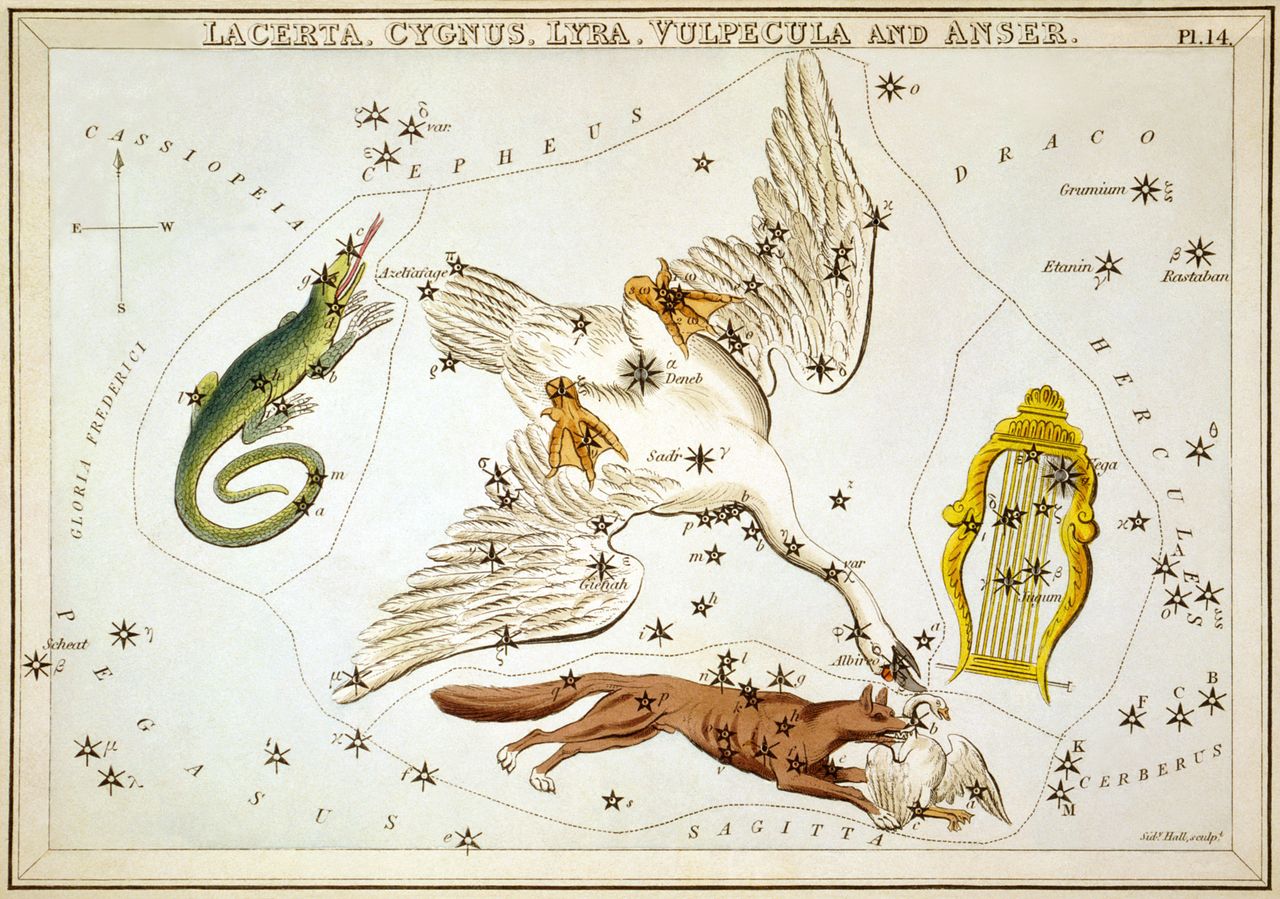
Lacerta, Cygnus, Lyra, Vulpecula and Anser
Lyra
Lyra (from Greek λύρα) is a small constellation. It is one of 48 listed by the 2nd century astronomer Ptolemy, and is one of the 88 constellations recognized by the International Astronomical Union. Lyra was often represented on star maps as a vulture or an eagle carrying a lyre, and hence sometimes referred to as Aquila Cadens or Vultur Cadens. Beginning at the north, Lyra is bordered by Draco, Hercules, Vulpecula, and Cygnus. Lyra is visible from the northern hemisphere from spring through autumn, and nearly overhead, in temperate latitudes, during the summer months. From the southern hemisphere, it is visible low in the northern sky during the winter months.
Vega, Lyra’s brightest star is one of the brightest stars in the night sky, and forms a corner of the famed Summer Triangle asterism.
In Greek mythology, Lyra represents the lyre of Orpheus. Made by Apollo from a tortoise shell, it was said to be the first lyre ever produced. Orpheus’s music was said to be so great that even inanimate objects such as trees, streams, and rocks could be charmed. Joining Jason and the Argonauts, his music was able to quell the voices of the dangerous Sirens, who sang tempting songs to the Argonauts.[3]
At one point, Orpheus married Eurydice, a nymph. While fleeing from an attack by Aristaeus, she stepped on a snake that bit her, killing her. To reclaim her, Orpheus entered the Underworld, where the music from his lyre charmed Hades. Hades relented and let Orpheus bring Eurydice back, on the condition that he never once look back until outside. Unfortunately, near the very end, Orpheus faltered and looked back, causing Eurydice to be left in the Underworld forever. Orpheus spent the rest of his life strumming his lyre while wandering aimlessly through the land, rejecting all marriage offers from women.[3]
There are two competing myths relating to the death of Orpheus. According to Eratosthenes, Orpheus failed to make a necessary sacrifice to Dionysus due to his regard for Apollo as the supreme deity instead. Dionysus then sent his followers to rip Orpheus apart. Ovid tells a rather different story, saying that women, in retribution for Orpheus’s rejection of marriage offers, ganged up and threw stones and spears. At first, his music charmed them as well, but eventually their numbers and clamor overwhelmed his music and he was hit by the spears. Both myths then state that his lyre was placed in the sky by the muses.[3]
Wikipedia
Fragment 511435
others at the Crown,
Original French: les aultres à la Courõne,
Modern French: les aultres à la Couronne,
Notes
Corona Borealias
Corona Borealis
Corona Borealis is a small constellation in the Northern Celestial Hemisphere. It is one of the 48 constellations listed by the 2nd-century astronomer Ptolemy, and remains one of the 88 modern constellations. Its brightest stars form a semicircular arc. Its Latin name, inspired by its shape, means “northern crown”. In classical mythology Corona Borealis generally represented the crown given by the god Dionysus to the Cretan princess Ariadne and set by him in the heavens. Other cultures likened the pattern to a circle of elders, an eagle’s nest, a bear’s den, or even a smokehole. Ptolemy also listed a southern counterpart, Corona Australis, with a similar pattern.
In Greek mythology, Corona Borealis was linked to the legend of Theseus and the minotaur. It was generally considered to represent a crown given by Dionysus to Ariadne, the daughter of Minos of Crete, after she had been abandoned by the Athenian prince Theseus. When she wore the crown at her marriage to Dionysus, he placed it in the heavens to commemorate their wedding. An alternate version has the besotted Dionysus give the crown to Ariadne, who in turn gives it to Theseus after he arrives in Crete to kill the minotaur that the Cretans have demanded tribute from Athens to feed. The hero uses the crown’s light to escape the labyrinth after disposing of the creature, and Dionysus later sets it in the heavens. The Latin author Hyginus linked it to a crown or wreath worn by Bacchus (Dionysus) to disguise his appearance when first approaching Mount Olympus and revealing himself to the gods, having been previously hidden as yet another child of Jupiter’s trysts with a mortal, in this case Semele. Corona Borealis was one of the 48 constellations mentioned in the Almagest of classical astronomer Ptolemy.
Fragment 511431
Aries
Fragment 511424
some at the Golden Eagle,
Original French: les vns a l’Aigle d’or,
Modern French: les uns à l’Aigle d’or,
Aquila
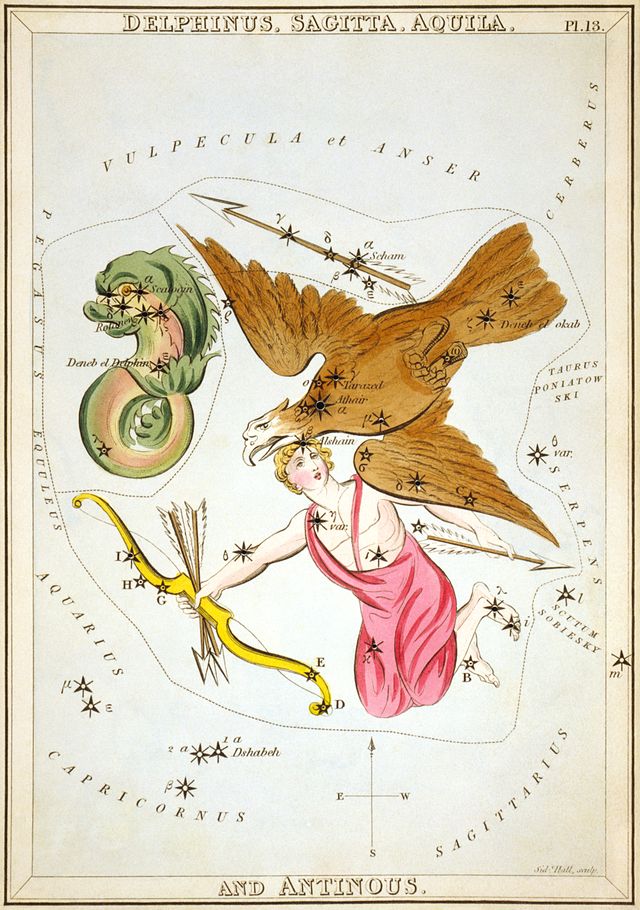
Aquila, with the now-obsolete figure of Antinous.
Aquila
Aquila is a constellation in the northern sky. Its name is Latin for ‘eagle’ and it represents the bird who carried Zeus/Jupiter’s thunderbolts in Greco-Roman mythology. Aquila lies just a few degrees North of the celestial equator. The alpha star, Altair, is a vertex of the Summer Triangle asterism. The constellation is best seen in the summer as it is located along the Milky Way.
Wikipedia
